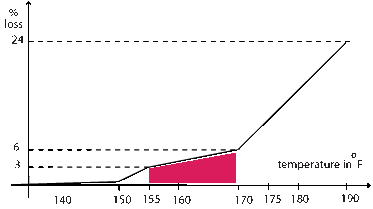What Temperature to Cook Beef Sausage
Cooking Meat
Cooked meat is without a doubt more palatable, but the main reason for cooking is to kill bacteria and make meat safe for consumption.
The factors that influence cooking are:
- Temperature - the higher the temperature the shorter the cooking time.
- Cooking medium - hot air conducts heat very poorly. Water conducts heat very well. A pizza maker can insert his hand briefly into the hot oven and he will not be hurt. If he inserted his hand to a pot with boiling water his hand will definitely be burned.
- Size and weight of meat. It takes some time for the heat to reach inside of the large meat piece and it will cook slower.

Meat piece A weighs more than B, but due to its small thickness, it will cook much faster.
Cooking produces meat loss which is of major importance for commercial producers but less for a hobbyist who's major concern is making the highest quality product.
The main losses are:
- Fat. Once the temperature of the meat reaches about 100° F (38° C) all fat tissues, regardless from which animal they come, become liquid. Connective tissue that surrounds them softens up but still holds them within. This tissue is composed from collagen and elastin protein, and if the temperature goes over the 100° F (38° C) mark, the connective tissue breaks down and the liquid fat particles are able to move around (this does not mean that they will leave the meat). There is very little fat loss between 150 - 190° F (66 - 88° C) or even up to the boiling point of water 212° F (100° C). There is a significant fat loss at temperatures over 248° F (120° C). This is the range that covers barbecuing, grilling or roasting. At those temperatures the fat leaks out of the meat.
- Water. Depending on a particular meat cut and the animal it came from, meat can contain up to 20% of protein. Those proteins bind molecules of water and they are enveloped by connective tissues. Some of them start to cook at 120° F (49° C), though most of them start to cook fast between 140° F (60° C) and 155° F (68° C). The effect is squeezing out the water and some loss of water soluble proteins. The meat shrinks. This loss depends on the meats internal temperature and happens regardless of what cooking media is used.

Meat cooking loss.
The shaded area in the drawing shows that the smallest cooking loss occurs when meat is cooked to 155 - 170° F (69 - 77° C) internal meat temperature. Cooking meat to 140° F (60° C) will result in an even smaller loss, but the majority people prefer the taste of meat, especially hams, when they are cooked to 155 - 169° F (69 - 77° C). A great way to cut down on losses is to save the meat stock and use it for soups or gravies.
Methods of Cooking
It is important that meat reaches the safe internal temperature. There are basically two methods:
- Cooking in a smoker or an oven.
- Cooking in water. A large pot plus thermometer is needed. The process can be simplified by using an electric water cooker, soup cooker or turkey fryer as these devices come with an automatic temperature control.
The fact to remember is that fat melts down at quite low temperatures and although it solidifies again, its looks are already gone. Fry a piece of solid fat on a frying pan and see what happens when it solidifies, it doesn't look the same. We can't avoid it altogether (unless we make cold smoked and air dried products), but there is no reason to intensify the problem by creating unnecessarily high temperatures.
When the source of heat is switched off, the product's internal temperature will still increase by a few degrees. This is due to the heat transfer from the surface into the inside of the meat. The temperature of the surface of the cooked product is higher than the temperature inside of it.
Cooking Pork
Sausages, hams and other pieces of meat are considered raw products and must be cooked after smoking. A sausage smoked at 100° F (38° C) for 6 hrs, will have a great smoky taste, flavor and color but it will still be a raw sausage like a fresh sausage that was only ground, mixed with spices, and stuffed into casings. Both of them must be cooked to safe temperatures before consumption.The U.S. Department of Agriculture recommends cooking fresh pork to an internal temperature of 160º F (71º C) and The National Pork Producers Council recommends an internal cooking temperature of 155º F (68º C) for maximum juiciness and flavor. Those extra 6° F (between 154° and 160° F) might kill a few more microbes and as a result the sausage might have a few hours longer shelf life, which is more important from a commercial point of view.
For a home sausage maker the inside temperature of the meat should fall between 154-160° F (68-72° C). We can stop cooking at 154° F (68° C) as most products will be of smoked variety and thus previously cured with salt and nitrite which gives us considerably more safety. Meats, which were not previously cured, will not be smoked, just cooked before consumption and the recommended temperature of 160° F should be observed. The lower the cooking temperature, the juicier and tastier the product is and the weight loss is also smaller.
Cooking Beef and Poultry
There are some sausages made entirely of beef though in most cases beef is mixed with pork. As beef can develop Salmonella, the Food Safety and Inspection Service of the United States Department of Agriculture has issued the following guidelines in June, 1999:
"Cooked beef and roast beef including sectioned and formed roasts, chunked and formed roasts, and cooked corned beef can be prepared using one of the following time and temperature combinations to meet either a 6.5-log10 or 7-log10 reduction of Salmonella":
| ° F | °C | 6.5-log10 lethality | 7-log10 lethality |
|---|---|---|---|
| 130 | 54.4 | 112 minutes | 121 minutes |
| 140 | 60.0 | 12 min | 12 min |
| 145 | 62.8 | 4 min | 4 min |
| 150 | 65.6 | 67 seconds | 72 seconds |
| 152 | 66.7 | 43 sec | 46 sec |
| 154 | 67.8 | 27 sec | 29 sec |
| 158 | 70.0 | 0 sec | 0 sec |
"Cooked poultry rolls and other cooked poultry products should reach an internal temperature of at least 160° F (71° C) prior to being removed from the cooking medium, except that cured and smoked poultry rolls and other cured and smoked poultry should reach an internal temperature of at least 155° F (69° C) prior to being removed from the cooking medium." (FSIS, June, 1999).
Cooking Fish
Fish is considered done when cooked to 145° F (63° C) internal temperature. A reliable test is to insert a fork or knife into the thickest part of the fish and twist. The flesh should "flake" (separate).
Summary
- The thermometer should be inserted in the thickest part of the meat.
- Cured meat will develop the best color when heated to 160° F (72° C). Most sausage recipes contain smoking instructions on required temperatures and times. At higher cooking temperatures sausage shrivelling will be more pronounced.
- In many poorly insulated smokers the cooking temperature must be almost 25° F higher than the corresponding meat temperature to notice any practical progress (the meat temperature follows the smoker's temperature but is behind by about 25° F).
- The advantage of cooking in the smokehouse is that smoke may be applied at the same time.
- Cooking losses are smaller when meat is boiled as opposed to baking in the oven.
- The surface area of a cooked product exhibits a higher temperature than the inside and even after the heat source is switched off, the heat will continue to transfer towards the inside. The internal temperature of the meat will still advance by a few degrees.
Meats that were not cured and smoked should be cooked to the following temperatures:
- Fish should reach 145° F (63° C) as measured with a food thermometer.
- All cuts of pork to 160° F (72° C).
- Ground beef, veal and lamb to 160° F.
- All poultry should reach a safe minimum internal temperature of 165° F (74° C).
- Leftovers to 165° F.
Source: https://www.meatsandsausages.com/sausage-making/cooking-meat

0 Response to "What Temperature to Cook Beef Sausage"
Post a Comment